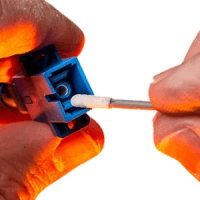Designing a fiber optic network isn’t just about choosing the right transceivers or laying down kilometers of cable. The best hardware in the world won’t help if your design is flawed from the start. Many of the problems that show up during install or operation come down to overlooked basics, signal loss, compatibility, poor planning, or simply not treating fiber like the precision medium it is.
Here’s a look at the most common mistakes made in fiber optic network design, and how to avoid them before they cost you time, money, and performance.
Underestimating Signal Loss
Signal loss, or attenuation, is one of the most misunderstood aspects of fiber design. It’s not just about distance. Every connector, splice, and bend adds loss. Stack a few of them together, and suddenly you’re out of spec, even on a “short” link.
A lot of designs assume that if the distance is under the transceiver’s rated range, the link will work. That’s a mistake.
Some key culprits:
- Too many patch panels or intermediate connections
- Dirty or low-quality connectors with high insertion loss
- Ignoring or miscalculating the total optical loss budget
Always calculate your end-to-end loss. Build margin into your design. And remember: factory specs assume perfect fiber under perfect conditions, not a cable tray full of dust and kinks.
Overbending Fiber or Poor Cable Routing
Fiber isn’t copper. You can’t just tug it around corners or crush it under a server rack and expect it to work. Overbending creates microfractures or tight bends that cause light to scatter, and performance to tank.
This happens more than you’d think:
- Overstuffed conduit or trays
- Ignoring the minimum bend radius during install
- Forcing fiber into sharp angles behind panels or switches
Keep your paths clean. Use radius guides. Protect jumpers from being bent or pinched, especially near connectors.
Using the Wrong Fiber Type

One of the fastest ways to kill a link is by mixing multimode and single-mode fiber. Or plugging optics designed for one into a plant built for the other. It can work, sometimes, but not as efficiently as it should.
Fiber types are not interchangeable:
- Single-mode fiber is made for long reach, small core, and tight laser alignment
- Multimode is shorter-range, cheaper, but only works with the right optics
If your design doesn’t match the fiber type with the transceiver wavelength and mode field diameter, you’ll be chasing ghosts later. Always verify what’s in the ground or overhead before you spec gear.
Not Cleaning Connectors

It’s hard to overstate how important clean connectors are. A speck of dust smaller than a grain of salt can scatter light or block a signal entirely.
Too many installs skip proper cleaning and inspection. That leads to:
- High insertion loss
- Intermittent link issues
- Damaged fiber tips that can’t be salvaged
Every connector should be cleaned before being plugged in, no exceptions. Use proper tools. Don’t blow on it or use your shirt. And inspect both ends of every jumper, even if it’s new.
Overlooking Environmental Conditions
Fiber is durable, but it’s not invincible. Temperature, humidity, vibration, and even UV exposure can affect performance, especially over time. The following must be checked:
- Running indoor-rated cable outdoors
- Using standard modules in uncooled cabinets
- Ignoring extended temp range requirements for remote sites
If your network runs into basements, rooftops, tunnels, or industrial spaces, don’t assume standard specs will hold. Use hardened gear where it counts, or be ready for degraded links when the seasons change.
Neglecting Future Scalability
It’s tempting to design just for today’s needs, the distance, bandwidth, and ports you currently need. But a fiber plant is long-term infrastructure. Tearing it up later because you didn’t plan for more cores, higher speeds, or different connectors can be painful.
- Installing high-count trunk fiber, even if you’re only using a few strands
- Using structured cabling with room to grow
- Keeping splice trays and enclosures accessible and labeled
Design with future transceiver types, connector trends, and upgrade cycles in mind. It’s cheaper to plan than to retrofit later.
Avoiding Errors and Building Optimal Systems
Long before anyone pulls cable or plugs in modules, a robust fibre optic network is already in the process of being built. The majority of issues start in the design stage, which is also where the majority of them can be eradicated.
Consider the laws of physics, and be aware of your loss budget. Be careful to match the sorts of fibres, maintain the cleanliness of your connectors, and make sure to plan for the conditions that your equipment will actually be living in.
Quick links
- An Easy-to-Follow Guide to Multi-Source Agreements for Modern Businesses
- Breaking Down Optical and Electrical Interfaces – What You Need to Know
- Build and Manage Optical Networks Smarter with OptiNetworks Insights
- Challenges and Mistakes Often Encountered in Fiber Network Design
- Everything You Need to Know About Choosing Network Hardware That Works
- Making Optical Networking Easier to Understand at OptiNetworks Insights
- Making the Right Call on Your Network Transceiver
- The Role of CMIs in Optical Transceivers
NETWORK PLANNING & DESIGN – The Brain Behind Every Reliable Telecom Network
— Er Bilal Rasool (@Er_Bilal_changa) April 19, 2025
In the world of telecommunications, everything begins with intelligent Network Planning & Design. It’s not just about connecting towers or laying fiber—it’s about creating a future-ready network that… pic.twitter.com/OxEGhm5GC0

